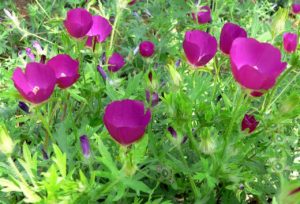Poppy Mallow/Callirhoe involucrata
What is it? The Purple Poppy Mallow or better known as the Winecup is a beautiful garden flower that eventually escaped into the wild and now grows across the rolling hills of Texas, Oklahoma, and the states surrounding Kansas. This plant is a simple flower, and there is not much you can do with it. But it is worth mentioning as it is a close look-a-like to the Cranesbill when in the young leaf stage.
Where to find it? You can find the Purple Poppy Mallow growing in sandy light soils, such as roadsides, valleys, plains, and the walkways of your garden. They grow throughout Central North America such as Texas, Oklahoma, Kansas, and even Utah. This flower does not do well in shade, but it does well in soils that other plants would not. However, if grown in domestic conditions, the Poppy Mallow lives longer than its wild cousin.

By Stan Shebs at https://commons.wikimedia.org/wiki/File:Callirhoe_involucrata_group.jpg
What to eat? There are several ways you can use the leaves and tubers in common dishes such as stews, soups, and salads. The root is said to be similar in taste to that of a sweet potato, and the leaves have more of an okra texture, so they should be prepared and cooked close to the way okra is cooked.
When to find it? You can find this plant throughout the year, but the best time to locate it is when the flowers are out and blooming. The best time to harvest the root is during the winter, but the leaves look very much like the Cranesbill and the Hemlock, so it will be both difficult and even dangerous when trying to locate the root during winter. Never taste the root unless you are one hundred percent sure, and always ask for professional help! The plant is winter hardy, and not susceptible to frost.
What does it look like? The purple poppy mallow looks like a small pretty little ground covering flower. The leaves are confusing, lobed and sort of fan like. They have roughly five sections with deep cuts into each of them. The leaves are hairy, a gray/green tone, with rounded teeth. The flowers are delicate looking; light purple, with five petals. The stems go out from the taproot similar to a vine, with hair covering the stem.
How to enjoy it? This flower is a beautiful garden addition, but it can also be used medicinally and for dinner plans. The root can be taken as a decoction to treat internal pain. As I mentioned above, the root can be eaten like a cooked sweet potato as it tastes similar, but it can also be eaten raw. The leaves can be added to stews as a thickener, or cooked for other dishes as you would cook okra.








